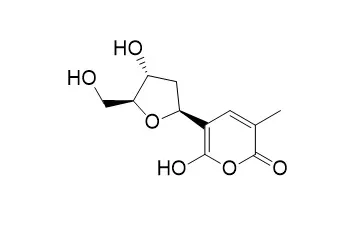| In vitro: |
| Mar Drugs . 2016 Apr 26;14(5):82. | | Cytotoxic Compounds from the Saudi Red Sea Sponge Xestospongia testudinaria[Pubmed: 27128926] | | Bioassay-guided fractionation of the organic extract of the Red Sea sponge Xestospongia testudinaria led to the isolation of 13 compounds including two new sterol esters, xestosterol palmitate (2) and xestosterol ester of l6'-bromo-(7'E,11'E,l5'E)-hexadeca-7',11',l5'-triene-5',13'-diynoic acid (4), together with eleven known compounds: xestosterol (1), xestosterol ester of 18'-bromooctadeca-7'E,9'E-diene-7',15'-diynoic acid (3), and the brominated acetylenic fatty acid derivatives, (5E,11E,15E,19E)-20-bromoeicosa-5,11,15,19-tetraene-9,17-diynoic acid (5), 18,18-dibromo-(9E)-octadeca-9,17-diene-5,7-diynoic acid (6), 18-bromooctadeca-(9E,17E)-diene-7,15-diynoic acid (7), 18-bromooctadeca-(9E,13E,17E)-triene-7,15-diynoic acid (8), l6-bromo (7E,11E,l5E)hexadeca-7,11,l5-triene-5,13-diynoic acid (9), 2-methylmaleimide-5-oxime (10), maleimide-5-oxime (11), Tetillapyrone (12), and norTetillapyrone (13). The chemical structures of the isolated compounds were accomplished using one- and two-dimensional NMR, infrared and high-resolution electron impact mass spectroscopy (1D, 2D NMR, IR and HREIMS), and by comparison with the data of the known compounds. The total alcoholic and n-hexane extracts showed remarkable cytotoxic activity against human cervical cancer (HeLa), human hepatocellular carcinoma (HepG-2), and human medulloblastoma (Daoy) cancer cell lines. Interestingly, the dibrominated C18-acetylenic fatty acid (6) exhibited the most potent growth inhibitory activity against these cancer cell lines followed by Compounds 7 and 9. Apparently, the dibromination of the terminal olefinic moiety has an enhanced effect on the cytotoxic activity. | | Pharmacogn Mag . Apr-Jun 2016;12(46):114-119. | | Studies on the Red Sea Sponge Haliclona sp. for its Chemical and Cytotoxic Properties[Pubmed: 27076747] | | Background: A great number of novel compounds with rich chemical diversity and significant bioactivity have been reported from Red Sea sponges.
Objective: To isolate, identify, and evaluate the cytotoxic activity of the chemical constituents of a sponge belonging to genus Haliclona collected from the Eastern coast of the Red Sea.
Materials and methods: The total ethanolic extract of the titled sponge was subjected to intensive chromatographic fractionation and purification guided by cytotoxic bioassay toward various cancer cell lines. The structures of the isolated compounds were elucidated using spectroscopic techniques including one-dimension and two-dimension nuclear magnetic resonance, mass spectrometry, ultraviolet, and infrared data, as well as comparison with the reported spectral data for the known compounds. X-ray single-crystal structure determination was performed to determine the absolute configuration of compound 4. The screening of antiproliferative activity of the compounds was carried on three tumor cell lines, namely the human cervical cancer (HeLa), human hepatocellular carcinoma (HepG2), and human medulloblastoma (Daoy) cells using MTT assay.
Results: This investigation resulted in the isolation of a new indole alkaloid, 1-(1H-indol-3-yloxy) propan-2-ol (1), with the previously synthesized pyrrolidine alkaloid, (2R, 3S, 4R, 5R) pyrrolidine-(1-hydroxyethyl)-3,4-diol hydrochloride (4), isolated here from a natural source for the first time. In addition, six known compounds Tetillapyrone (2), norTetillapyrone (3), 2-methyl maleimide-5-oxime (5), maleimide-5-oxime (6), 5-(hydroxymethyl) dihydrofuran-2 (3H)-one (7), and ergosta-5,24 (28)-dien-3-ol (8) were also identified. Most of the isolated compounds exhibited weak cytotoxic activity against HepG-2, Daoy, and HeLa cancer cell lines.
Conclusion: This is the first report of the occurrence of the indole and pyrrolidine alkaloids, 1-(1H-indol-2-yloxy) propan-2-ol (1), and the - (1-hydroxyethyl)-3,4-diol hydrochloride (4), in the Red Sea Haliclona sp.
Summary: From the Red Sea Haliclona sp. two alkaloids with indole and pyrrolidine nuclei, 1-(1H-indol-2-yloxy) propan-2-ol-(1) and pyrrolidine-(1-hydroxyethyl)-3,4-diol hydrochloride (4) were isolated and fully characterized; in addition to six known compounds (2, 3, 5-8)The absolute configuration and the three-dimension stereo-molecular structure of compound 4 were determined by X-ray crystallographyThe different extracts and isolated compounds showed weak cytotoxic activity against HepG-2, Daoy, and HeLa cancer cell lines. | | Mar Drugs . 2007 Jun 25;5(2):40-51. | | Antifungal activity evaluation of the constituents of Haliclona baeri and Haliclona cymaeformis, collected from the Gulf of Thailand[Pubmed: 18463723] | | A new compound maleimide-5-oxime was isolated, together with 3,4-dihydroxybenzoic acid, Tetillapyrone, from the ethyl acetate extract of the marine sponge Haliclona baeri while Tetillapyrone, norTetillapyrone, p-hydroxybenzaldehyde and phenylacetic acid were isolated from the ethyl acetate extract of Haliclona cymaeformis, collected from the Gulf of Thailand. The structures of Tetillapyrone and norTetillapyrone were re-examined using HMBC correlations. Maleimide-5-oxime, Tetillapyrone and norTetillapyrone were found to be inactive against three human tumor cell lines (the estrogen-dependent ER(+) MCF-7, the estrogen-independent ER(-) MDA-MB-231 and NCI-H460. Maleimide-5-oxime, p-hydroxybenzaldehyde, phenylacetic acid, Tetillapyrone and norTetillapyrone were evaluated for their growth inhibitory effect against seven yeasts and eight filamentous fungi. Only norTetillapyrone showed antifungal activity, with a preponderance on the dermatophytic filamentous fungi. |
|






 Cell. 2018 Jan 11;172(1-2):249-261.e12. doi: 10.1016/j.cell.2017.12.019.IF=36.216(2019)
Cell. 2018 Jan 11;172(1-2):249-261.e12. doi: 10.1016/j.cell.2017.12.019.IF=36.216(2019) Cell Metab. 2020 Mar 3;31(3):534-548.e5. doi: 10.1016/j.cmet.2020.01.002.IF=22.415(2019)
Cell Metab. 2020 Mar 3;31(3):534-548.e5. doi: 10.1016/j.cmet.2020.01.002.IF=22.415(2019) Mol Cell. 2017 Nov 16;68(4):673-685.e6. doi: 10.1016/j.molcel.2017.10.022.IF=14.548(2019)
Mol Cell. 2017 Nov 16;68(4):673-685.e6. doi: 10.1016/j.molcel.2017.10.022.IF=14.548(2019)